
Positive Behaviour for Learning Policy
Created: September 2019
Updated: February 2023
Reviewed September 2023
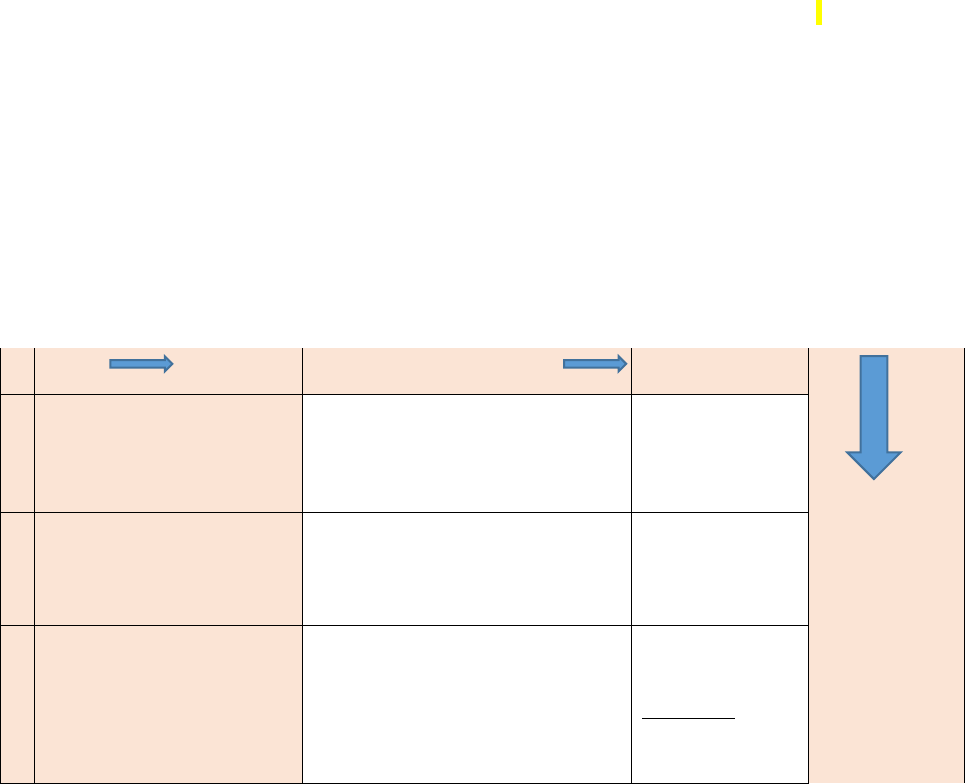
In developing a policy for Behaviour for Learning, the Oasis vision is important. Our vision is for
community, a place where everyone is included, making a contribution and reaching their God given
potential. Our ethos is a statement of who we are and it is an expression of our character. Rooted in
the story and beliefs of Oasis, we describe our ethos through a particular set of values that inform and
provide the lens on everything that we do.
• A passion to include.
• A desire to treat people equally, respecting differences.
• A commitment to healthy, open relationships.
• A deep sense of hope that things can change and be transformed.
• A deep sense of hope that things can be changed and transformed.
• A sense of perseverance to keep going for the long haul.
Our approach to behaviour, is underpinned by the Oasis Ethos and the 9 habits.
This policy has been created in conjuction with the OCL Behaviour for Learning Policy (April 2022), the
Paul Dix book ‘When the Adults change, Everything Changes’ and current OFSTED Framework..
This behaviour policy is underpinned by 4 key levers;
1. Oasis Academy Henderson Avenue vision and values
2. Our Personal Development and Curriculum
3. Academy Behaviour systems, structures and routines
4. Behaviour Training and Professional Development for staff.
Lever 1: Oasis Academy Henderson Avenue vision and values
Lever
Academy Leaders
Academy Staff
Harmonious
climate for
learning
where all
young
people can
flourish and
thrive.
1
Academy Vision and
Values (in line with the
Oasis ethos)
Set the vision and values, in the context of
the Oasis ethos and 9 Habits. Ensure
overcommunication, ensure all decisions
are embodying and embracing the vision
and values of the Academy and Oasis.
Embrace and embody
the vision and values
in all that you do and
deliver
2
Personal Development
Curriculum (Oasis Ethos,
Enrichment, Extra-Curricular,
PSHCE, CIAG)
Set, design and agree the pastoral
curriculum in line with vision and values
Deliver the curriculum
effectively and
inspirationally
3
Academy Behaviour
Systems, Structures
and Routines
Evaluate, design, set the systems,
structures and routines that will ensure a
harmonious climate for learning in line with
the vision and values
Implement, the
Academy’s behaviour
systems, structures
and routines,
consistently and in
line with the vision and
values

4
Behaviour Training and
Professional
Development for staff
Design, create and deliver a cohesive and
comprehensive Professional Development
strategy to develop all staff in their pastoral
and behaviour development in order to
uphold the vision and values.
Engage and commit to
the professional
development,
including expert and
specialist pastoral
training
The localised behaviour policy is a reflection of the core trust document outlining our
aspirations for both primary and secondary aged children and young people. It captures the
essence of what we strive to achieve as part of Oasis, and applies to all of our children and
young people, in all phases, in all of our academies. The statement of intent is based on
cutting edge educational research into the science of learning (including how memory
works) and character development. The statement of intent also aims to develop active
citizens who have a strong understanding of the world around them and a desire and drive
to positively impact their academy, local, national and global community
The statement of intent outlines how together as staff, children and young people, parents
and carers we have implemented a curriculum that will positively impact on pupils.
An Oasis learner will become someone who:
• is comfortable in their own skin and is able to continuously explore who they are
becoming
• has the expertise they need to succeed, lead and serve others.
• wants to make the world a better place and feels able to do so.
• Is able to keep themselves and others safe
• can communicate effectively and confidently in order that they feel included in all
scenarios.
• is an active part of a network that supports others. • seeks to include others, is other-
centred and celebrates difference.
• has an inner sense of purpose, conviction and belief.
• has a values approach to life and a sense of what is right and wrong through the lived
experience of the 9 Habits.

We are committed to achieving great outcomes for all our pupils, academically, socially and
emotionally. We place a high value on children’s personal, social and emotional well-being as well as
academic success.We believe that this will give the pupils real choices in the future and improve
their life chances.
At Oasis Henderson Avenue we will work with families and support them to create a strong
community both in and out of school. Our understanding of the diverse community that we serve
will enable staff, pupils and parents to work together to achieve the same goal.
Our bespoke, broad and balanced curriculum meets the needs and interests of all of our pupils. We
equip children with the knowledge and the skills that they need to grow to become independent and
confident learners. Children choose to behave well and staff guide them develop problem solving
skills to overcome barriers to learning.
Teachers feel empowered to take risks and plan exciting, immersive lessons which engage and
involve children at all levels. We encourage a culture of trust where staff mentor and coach each
other providing both support and challenge to continually allow for self-evaluation and reflection.
Children feel valued, safe and supported in school knowing that adults will take the time to listen,
support and find solutions to challenges whatever they might be. The whole school community will
demonstrate the 9 Habits and endeavour to use them as a guide in all aspects of school life.
We are committed to a model of inclusion, hope, perseverance, healthy relationships and compassion
throughout all aspects of the life and culture of every hub and every academy community. The Oasis
Education Charter sets out our commitment to work in partnership with our communities to transform
lives and create a culture of excellence for all.

Our policy, which runs alongside the OCL Behaviour for Learning Policy, aims to ensure the consistent
application of Academy behaviour protocols and practice, so that our students learn to:
• Take responsibility for their own behaviour and choices, understanding the impact they have
on others
• Develop positive learning behaviours including: self-direction, resilience and self-control
• Self-regulate (as developmentally appropriate) their own behaviour by developing skill and
confidence in managing conflict and difficulty
• Develop strong dispositions and attitudes to their own and others’ learning and well-being.
• Understand what constitutes ‘responsible behaviour’ to prepare for life in modern Britain and
Global citizenship in the 21st Century
• Develop their ethical approaches and values in their lives.
Oasis Academy Henderson Avenue is committed to creating an environment where exemplary
behaviour is at the heart of productive learning. Everyone is expected to maintain the highest
standards of personal conduct, to accept responsibility for their behaviour and encourage others to
do the same. As members of our community, we adhere to the values of being: ‘Respectful, Ready,
and Safe.’
At OAHA we aim to:
• Provide a safe, comfortable and caring environment where optimum learning
takes place
• Provide clear guidance for children, staff and parents of expected levels of
behaviour
1. Staff – Policy will be placed upon the academy website, staff
noticeboard and will be periodically reviewed at inset and phase
meetings. Application of the policy will be monitored via learning
walks, observations, drop ins and in class support from the SEMH
team.
2. Pupils - Student council and buddies to review and discuss policy to
create a child friendly behaviour policy. This will then be fed back to
classes with class teachers supporting and promoting understanding of
the policy.
3. Parents – Policy will be available on the academy website and via
paper copies at the main office. Promotion of the policy via the weekly
newsletter.
• Use a consistent and calm approach
• Ensure all adults take responsibility for managing behaviour and follow-up
incidents personally
• Ensure all adults use consistent language to promote positive behaviour and
• Use restorative approaches instead of punishments
Purpose of the behaviour policy
To provide simple, practical procedures for staff and children that:
• Foster the belief that there are no ‘bad’ children, just ‘bad choices’
• Encourage children to recognise that they can and should make ‘good’ choices
• Recognise individual behavioural norms and respond appropriately
• Promote self-esteem and self-discipline
• Teach appropriate behaviour through positive intervention
All staff must:
• Meet and greet pupils at the start of the day
• Be at the door of their rooms at the start of each session
• Consistently reinforce the expectations of ‘Wonderful Walking’ and ‘Legendary Line-ups’
when children are moving around the academy to ensure a calm and orderly environment at
breaks and lunchtimes
• Proactively focus upon children who are failing to meet expectations
• Always redirect children by referring to the 3 rules: ‘Be Ready, Be Respectful and Be Safe’
The Principal and The Senior Leadership Team must:
• Be a visible presence around the school
• Regularly celebrate staff whose efforts go above and beyond expectations by nominating
members of staff for the Praise Board which is located in the photocopying room.
• Regularly celebrate children whose efforts go above and beyond expectations by …….
• Encourage use of positive praise, phone calls/texts/notes home and certificates/stickers
• Ensure staff training needs are identified and met
• Use behaviour records to target and assess interventions ( Class behavior logs & CPOMs)
• Support teachers in managing children with more complex or challenging behaviours
Members of staff who manage behaviour well:
• Deliberately and persistently catch children doing the right thing and praise them in front
of others
• Know their classes well and develop positive relationships with all children
• Relentlessly work to build mutual respect
• Remain calm and project positive emotions and attitudes even in challenging and
confrontational situations
• Demonstrate unconditional care and compassion
• Consistently apply positive strategies which develop excellent behaviour:
1. IDENITIFY the behaviour we expect
2. Explicitly TEACH behaviour
3. MODEL the behaviour we expect
4. PRACTISE behaviour
5. NOTICE excellent behaviour
6. CREATE conditions for excellent behaviour
• Consistently use an agreed language and script.
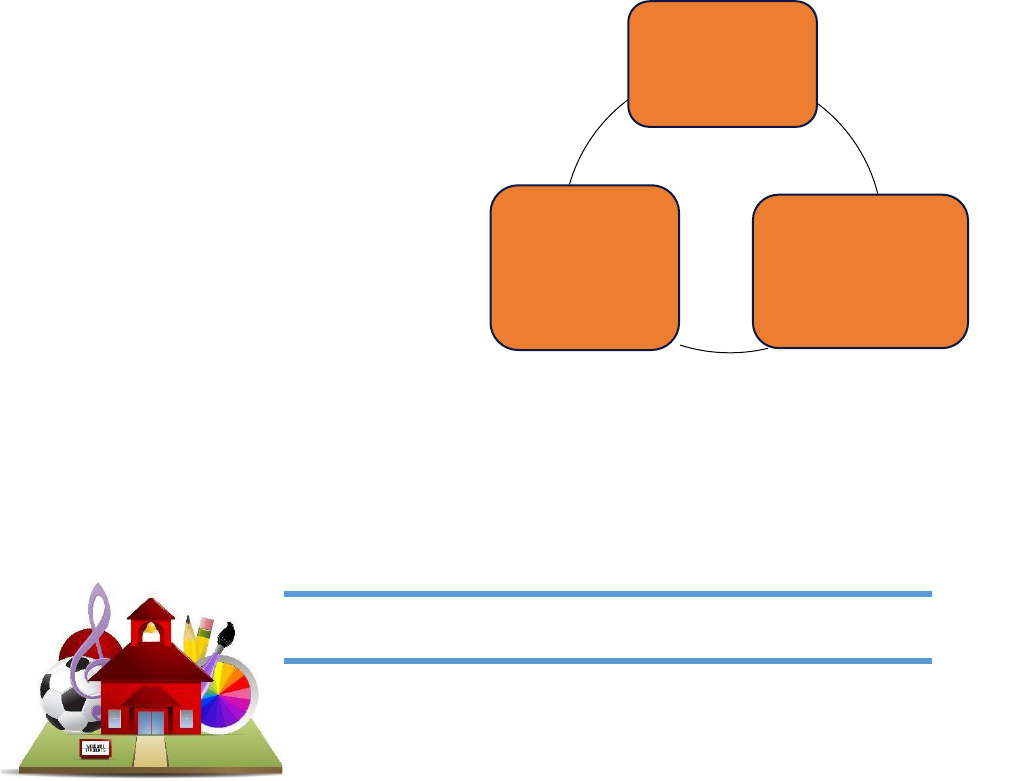
• Children want teachers to:
• Give them a ‘fresh start’ every lesson
• Help them learn and feel confident
• Be just and fair
• Have a sense of humour
LEVER 2: PERSONAL DEVELOPMEMT CURRICULUM
The Oasis Primary curriculum has been designed to ensure that our students thrive, achieve and
flourish. It enables them to understand what it is to be human and equips them for life so that they
become kind and model citizens. Our curriculum not only develops our young people academically
but socially, emotionally, culturally, physically and spiritually. In order to achieve the vision which
Academy Leaders set out, students need to develop both competence and character. Academic and
pastoral curricula do not sit in isolation, they complement each other and support the vision.
Character Education at OAHA
This curriculum consists of everything outside of the
academic curriculum, and covers:
1. The ‘taught’ character curriculum:
• PSHCE (physical, social, health, mental
wellbeing and cultural education)
• Oasis ethos values, 9 Habits and Living
and Learning skills.
• Enrichment activities (e.g. trips and
visits, noncurricular courses or workshops, etc.)
• Extra-curricular programme (e.g.
before- and afterschool clubs and societies)
2. The culture created by staff behaviours and the
systems and routines of a school This is often less tangible and may be seen in
the way assemblies are conducted, in corridor conversations and in signs and
symbols around school. This is often summed up as ‘the way things are around
here’.
Ex
Knowledge
Rich Academic
Curriculum
Untaught Pastoral
'Culture'
Curriculum
(
displays,
assemblies,
rituals, routines,
celebrations)
Taught Pastoral
Curriculum
(
Extra
Curricular,
PSHCE,
etc)
Extra Curriculum Provision: football, athletics, cross country, judo, choir
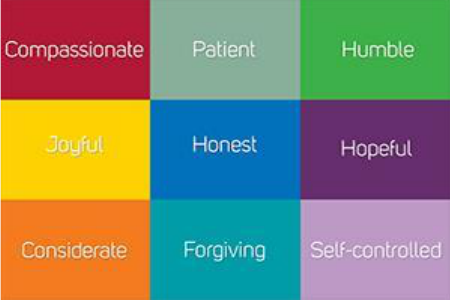
Living and learning skills are promoted throughout the academy.
Inclusion, equality, healthy relationships, hope and perseverance permeate all
aspects of the life and culture of Oasis Academy Henderson
Avenue.
We believe that continually developing our character to become
the best version of ourselves is important for every student and
staff member alike. Therefore, we actively promote and practise
the Oasis 9 Habits. The 9 Habits are fundamental and underpin
all actions, approaches and relationships in the management of
student behaviour. The 9 Habits inspire us to behave in a way
that enables us to be our best and bring our best to our learning
and the community we are a part of.
We aim to develop an understanding and tolerance of each other through
knowledge, mutual respect, forgiveness and believing the best of one another.
Individual rights will be respected and choice will be exercised within a culture of
self discipline. The 9 Habits also remind staff and students of our responsibilities to
each other.
Our curriculum has been designed to ensure our young people thrive, achieve and flourish. It
enables them to understand what it is to be human and equips them for life so that they become
kind and model citizens. Our curriculum not only develops our young people academically but
socially, emotionally, culturally, physically and spiritually.
In order to achieve the vision which Academy leaders set out, students need to develop both
competence and character. Academic and pastoral curricula do not sit in isolation, they complement
each other, and support the vision. They are equal in importance.
This curriculum consists of everything outside of the academic curriculum, and covers:
1) The ‘taught’ character curriculum:
• The Oasis Ethos values and 9 habits
• CEIAG (careers education, information, advice, and guidance)
• PSHCE (physical, social, health, team work skills, RE and cultural education)
• Enrichment activities (eg trips and visits, non-curricular courses or workshops, etc)
• Extra-curricular programme (eg. before- and after-school clubs and societies)

2) The culture created by staff behaviours and the systems and routines of a school
This is often less tangible and may be seen in the way assemblies are conducted, in form
time / family time, in corridor conversations, and in signs and symbols around school.
This is often summed up as ‘the way things are around here’
We now have a primary and secondary Oasis PSHCE curriculum which underpins our behaviour for
learning strategy.
‘Taught’ Pastoral Curriculum: Academy Leaders
Ensure that the curriculum outlined above is selected, structured and presented in a way that
renders it comprehensible and inspiring to young minds. This is the same principle as in the taught
academic curriculum, because they are equally important.
• Leaders have absolute clarity as to what excellent pastoral education should look like
in their Academy, for all year groups and in each area.
• Leaders ensure that the pastoral curriculum taught in their Academies focuses upon powerful
knowledge and experiences that build cultural capital and develop students’ ability to keep
themselves safe, healthy physically, mentally and with respect to relationships.
• Leaders ensure that the pastoral curriculum is carefully planned, so that every year students’
learning provides foundations for what they do in the following year(s). They ensure that
everything students learn pastorally empowers students to realise their potential and
prepares them for success in the next phase of their lives.
‘Taught’ Pastoral Curriculum: Academy Staff
Academy staff have a duty to portray the pastoral curriculum (including enrichment, extra-curricular,
Oasis ethos and values, CEIAG and PSHCE) content in a way that renders it comprehensible to
students. Enlist student participation, targeting content towards all students, particularly those who
are not necessarily interested in the development of character or their preparedness for adult life,
and who need to be persuaded of its value:
Curriculum Design:
• Scheduling / interleaving pastoral content
• Building learning on a platform of what students already know, and building new learning on
foundations of prior knowledge
• Wherever possible, rooting learning in a real-life context so that pupils can see the relevance
of their learning and skills development
• Designing activities that direct student thinking to the right areas
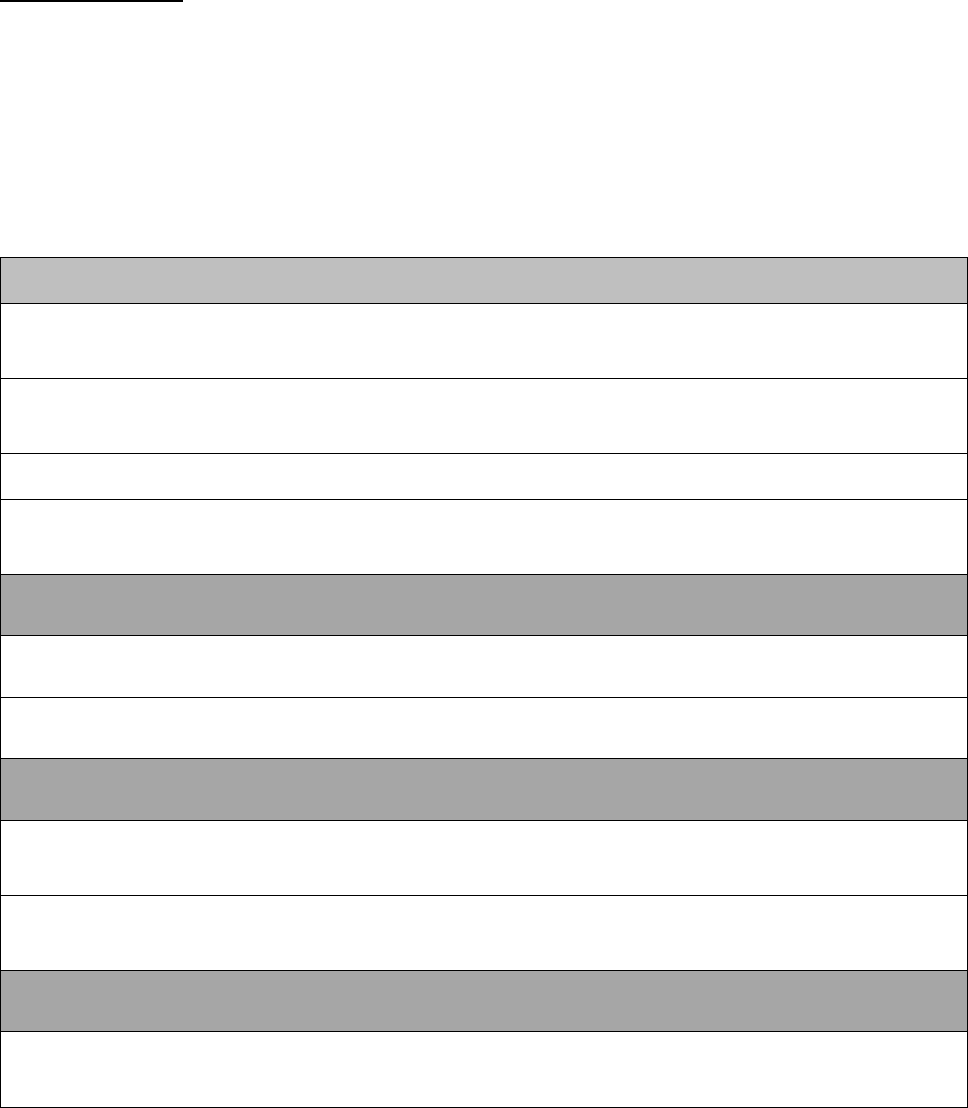
• Providing time for learners to practise and apply in other contexts, and encouraging them to
do so – make learning flexible
Curriculum Delivery:
• Representing new concepts to students.
• Exposing misconceptions, exploring them and correcting where necessary
• Encouraging concentration and mental effort.
• Praising effort rather than intelligence so that students begin to see the link between hard
work and their outcomes
More specifically:
Planning, so that pastoral curriculum content is rendered comprehensible to young minds.
Where relevant learning objectives are precise, clear, important, achievable, so that learning is precisely
targeted at student knowledge gaps.
Pastoral /Academy Staff ensure that learning outcomes demonstrates achievement of the objective, so
that students clearly demonstrated their learning.
Pastoral /Academy Staff pitch learning correctly, so that all students are sufficiently challenged.
Pastoral /Academy Staff sequences pastoral learning objectives and outcomes over time, so that a clear
picture of student pastoral emerges.
Delivery, so that every minute pastorally is used well.
Pastoral /Academy Staff use time effectively, so every minute of pastoral time is made to count.
Pastoral /Academy Staff ensure activity transitions are slick, so that no learning time is wasted.
Engagement, so that students feel enriched and joy of learning is nurtured.
Pastoral /Academy Staff demonstrate a love of learning and of their pastoral roles, so that students never
feel they ‘have’ to learn about a topic but ‘need’ to.
Pastoral /Academy staff contextualise pastoral learning, so that students know the value of the learning
beyond summative assessment.
Student motivation, so that students see the value in effortful learning.
Pastoral /Academy Staff develop students’ intrinsic motivation, so that students are driven towards
mastery for its own sake, especially when learning gets tough.
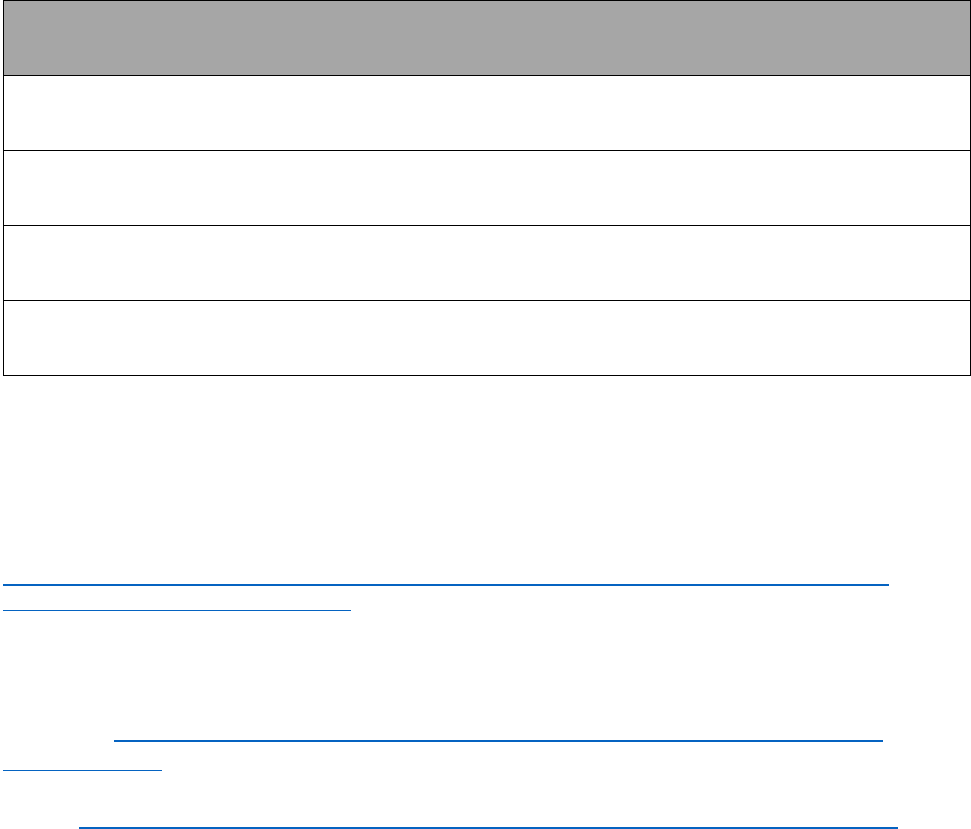
Assessment, checking for understanding and feedback, so that pastoral learning can be observed and
gaps in understanding can be bridged.
Pastoral /Academy Staff ensure that pastoral experience builds from prior learning, so that students make
links with what they already know.
Pastoral /Academy Staff adapt their planning and delivery based on data gathered, so that instruction is
targeted at knowledge gaps.
Pastoral /Academy Staff feedback (oral and written, including. reports) makes students aware of how to
improve, so that students don’t repeatedly make the same errors.
Over time, student work (in books or similar) is of good quality and quantity, so we can see that good
student outcomes are a pattern over time.
Relevant reference material:
Leaders use the new Oasis curriculum.
Statutory guidance on relationships education, relationships and sex education (RSE) and
health education has been released by the DfE
https://www.gov.uk/government/publications/relationships-education-relationships-and-sex-
education-rse-and-health-education
Careers, Information, Advice and Guidance for Secondary and All-Through Academies
Leaders use https://www.gov.uk/government/publications/careers-guidance-provision-for-young-
people-in-schools in order to support their curriculum planning and delivery of Careers Information
Advice and Guidance. The Gatsby Benchmarks offer fundamental advice and guidance to school
leaders: https://www.gatsby.org.uk/uploads/education/good-career-guidance-handbook-digital.pdf
Enrichment and Extra Curricular
An innovative and creative enrichment curriculum should be offered in all Academies that ensures
the development of the whole child-culturally, socially, emotionally and physically. This could include
a diverse range of activities: music, debating, cooking, fashion, crafts, art, drama and media and
technology. Additionally, students should have the opportunity to explore sports and physical
activity outside of their timetabled lessons.
Culture
The character development of students is also shaped by more intangible learning and is often
described as culture or ‘the way things are around here’. A school can describe their values and
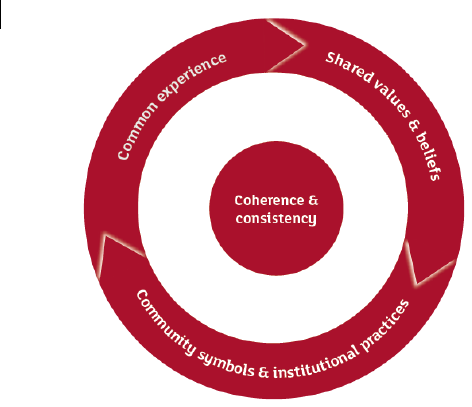
beliefs, but unless these beliefs are lived out in the common experience for pupils and staff, they will
stay as words on a sign or prospectus. A school can claim to be ‘a caring safe community’ for
example, but this is meaningless if the contextual safeguarding issues aren’t considered e.g. to the
pupil who is scared to come to school because of a bully; who feels ‘invisible’ in the corridors and
classrooms; or indeed to the bully who knows he can fight on every corridor. A school may claim to
value ‘endeavour’ but if there are no opportunities to learn what that looks like; if teachers don’t
narrate the concept regularly as a reminder and show what it looks like; or if there are no
celebration opportunities in tutor time or assembly for pupils to be rewarded for hard work, this
claim becomes empty.
Community symbols and organisational systems,
routines and practices are a way of driving the
common experience of the values of the school, and
are ways to communicate the values to all
stakeholders. These practices can look like uniform
policy, behaviour policy, assemblies, the format of
tutor or circle time, the way pupils are greeted in the
morning, the expectations of staff on duty; anything
which dictates ‘the way things are around here’.
In order to ensure that the Academy culture delivers a
coherent message of the values and experience you
want to cultivate, and ensures pupils really
experience the curriculum you want, thought must be
given to the systems, structures and routines you put
in place, and how to ensure they are sustainable and consistent.

Lever 3:
Academy behaviour systems, structures and routines
LEVER 3: ACADEMY BEHAVIOUR SYSTEMS, STRUCTURES AND
ROUTINES
Systems, Structures and Routines: Academy Leaders
Ensure systems, structures and routines are in place to provide environments which manage student
behaviour, both during structured (lesson) and unstructured time (break/lunch), promoting and
developing positive learning and life habits and ensuring focus from all students.
Leaders create and manage a whole-school behaviour systems and structures that empower:
• Students and staff to feel safe and secure at all times and during all Academy activities.
• Systems, structures, and routines that are simple, clear and routinely and consistently
followed by all staff and understood by all students and their families.
• All staff to intervene swiftly and consistently in order to redress deteriorating behaviour for
individuals or groups of students.
• Teachers to deliver effective lessons, reflecting the approaches outlined in the OCL Learning
Policy to ensure low level disruption is prevented or addressed swiftly and effectively.
• Leaders to create and maintain a culture, both in and outside of lessons, in which excellent
behaviour is the norm and both staff and students understand their responsibility for explicitly
promoting and developing positive learning behaviours. These behaviours include, but are not
limited to, self-direction, resilience, and self-control.
• The use of mobile phones and social media is curtailed during academic learning time
Systems, Structures and Routines: Academy Staff
All Academy staff to implement and follow these systems, structures, and routines consistently.
Academy staff to seek support and further guidance if this is difficult.
Academy staff are to ensure student behaviour, both during structured and unstructured time,
promotes and develops positive learning and life habits.
This is best achieved by:
• Planning high quality routines and training students in these, including for unstructured time.
• Seeking support, guidance and further training when there are difficulties in managing student
behaviour that cannot be overcome
• The academy aims to build a focused and productive Academy climate for learning, in which
behaviours falling short of expectations are consistently addressed and corrected; and
restorative conversations harnessed to enable students and adults to better understand and
respond to conflict.

• The academy ensures students and their parents/carers understand and can see the
relationship between their choices about learning behaviour and their learning outcomes.
OCL Learning Policy Guidance for lessons (Quality First Teaching)
Our Trust Learning Policy recognises that Academy leaders must create an environment which
manages student behaviour, promoting and developing positive learning habits and ensuring focus
from all students. They must do this so that teachers are supported in a single-minded focus on
teaching great lessons, free from the distractions of disruptive behaviour.
The Trust Learning Policy states that teachers should ensure that students learn to manage their
own behaviour, promoting and developing positive learning habits and ensuring focus from all
students, including those who are easily distracted.
Teachers have a responsibility to explicitly promote and develop learning behaviours such as self-
direction, resilience, and self-control so that students can fulfil their true potential. At times students
can be excitable, boisterous, and easily distracted. Teachers need to channel these behaviours, in
part as a matter of safety, but principally to ensure that students and teachers are focused on the
learning. This is best achieved by:
• Planning high quality routines and training students in these, including for independent
learning
• Building a focused and productive and trauma responsive classroom culture
• Maintaining focus throughout the lesson
• Ensuring students and their parents/carers understand and can see the relationship between
their choices about learning behaviour and their learning outcomes
When?
What?
Quality First Teaching
During the ‘I do’ phase of the
lesson.
Economy of Language
Clear instructions to students. Support this with a visual aid. Try something like
MINT (Materials, In… groups, pairs etc, Noise Level, Time Limit)
Clear learning objectives
Ambitious learning goals for all pupils. Do they all know where we are heading
in today’s lesson?
A worked model
Showing students how to succeed at a task by modelling it step-by-step
yourself.
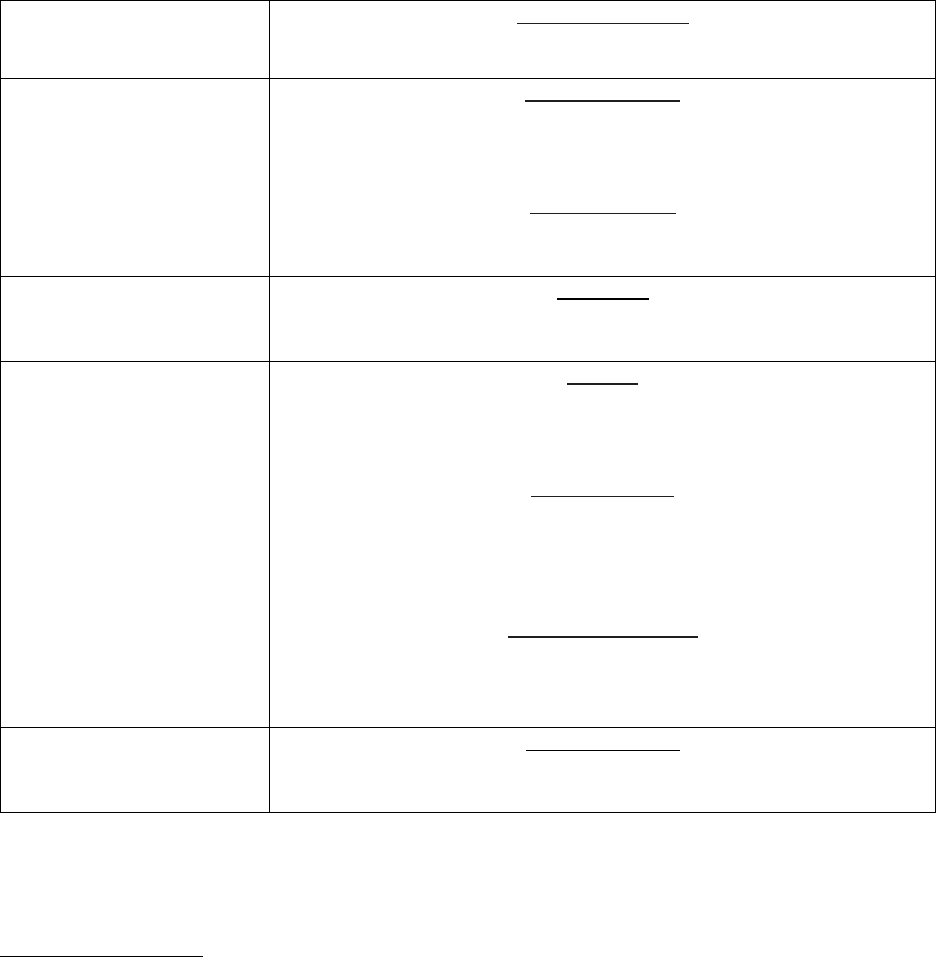
Chunk and sequence
Break-down knowledge into bite-sized chunks so that learners can access it
efficiently, accelerating progress.
During the ‘We do’ phase of
the lesson.
Guided Instruction
Orate the thinking process verbally and visually on the whiteboard or under
the visualiser. Ask the students to suggest the next steps.
Backwards fading
Showing students how to succeed at a task by asking them to complete
selected steps of the model.
During the ‘You do’ phase of
the lesson
Scaffolding
Guidance and structure to support students to meet the demands of the
independent task.
Checking for understanding
(at any point in the lesson)
Cold-call
Directed teacher questioning of a range of targeted students throughout the
lesson.
Reject self report
Carrying out whole-class assessment so that you know where all students are
in their learning and can be responsive in your practice. This might be through
the use of mini whiteboards, iPads or other means of collection.
Intentional Monitoring
Circulate the room during lessons to check for engagement, progress and
misconceptions. Use this information to be responsive and feedback to whole
class, groups of students or individuals.
Supporting Literacy (at any
point in the lesson)
Teacher of literacy
Explicitly teaching vocabulary and refining students’ vocabulary,
comprehension and oracy in all lessons.
Common approaches to rewards and consequences
Rationale for Rewards
• It is important to focus on the positive: catch students being good, focus on those who are
“doing the right thing”, using the phrase “thank you” as the final part of a request, providing
choice, using tactical ignoring.
• Celebration of positive behaviour underpins all aspects of Academy life
• De-escalation and diffusion is used first, in the vast majority of cases
• Focusing on raising children’s self-esteem to fulfil potential
• Effective partnerships with parents, carers and external agencies
• Reflect constantly on the effectiveness of one’s own behaviour management practice and be
open to advice from others
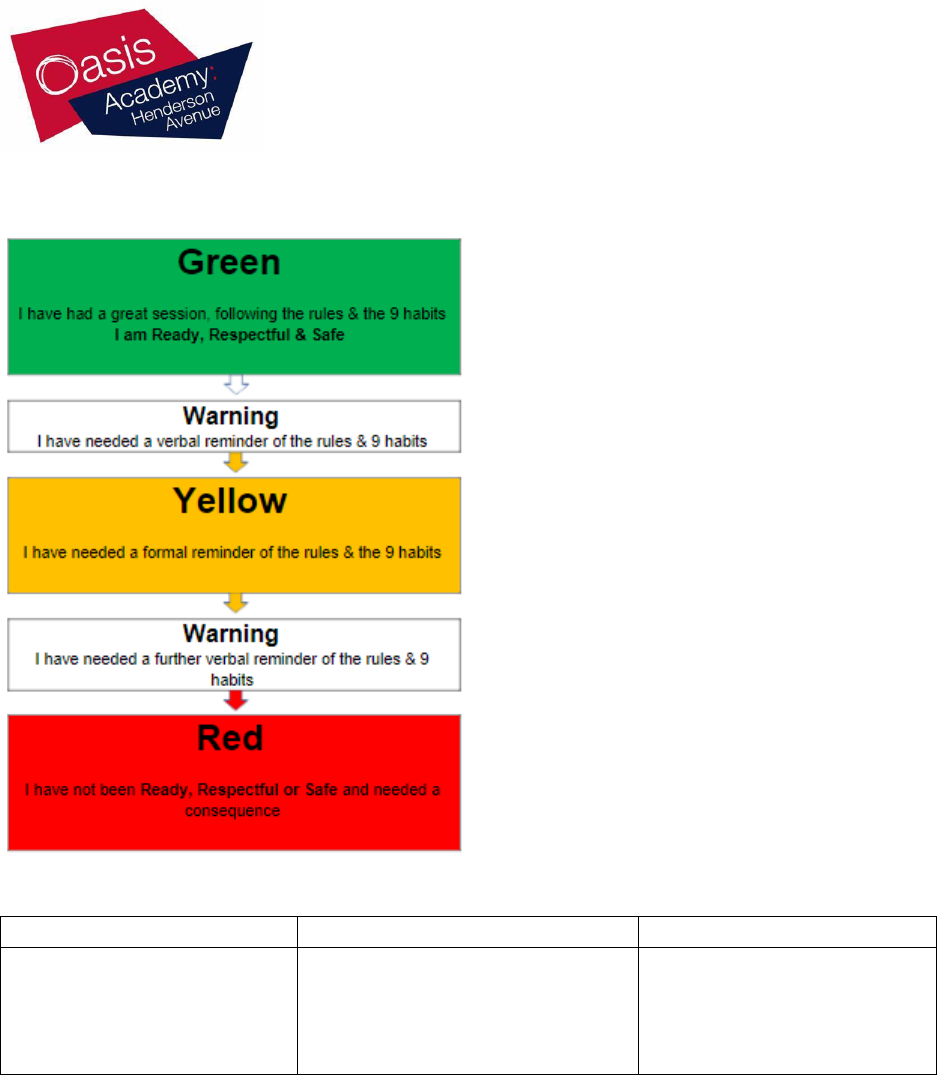
Rewards for students are highly effective in promoting good behaviour. It is important they are
applied consistently with all students. The rewards are in-line with agreed local and Academy
specific protocols to ensure consistency within each Academy. Rewards at the academy include:
Behaviour 1 Page guide
Cards should be re-set to green at the
beginning of each session (playtime,
lunchtime, home time) so that all
children start each session on green
Gentle warnings may be given
(privately) for behaviour that does not
warrant an Amber card
When an Amber card is given, this must
be displayed by a member of staff (no
walk of shame or changing own cards).
A restorative conversation is needed to
turn back to green at the end of the
session
Red cards may only be displayed by
staff. Children can work up to a red card
for repeated poor behaviour within a
session or may be given an instant red
in certain circumstances
Warning (Examples)
Amber Card (Examples)
Red Card (Examples)
Talking inappropriately
Shouting out
Low-level disruption
Repeated refusal to work
Deliberately ignoring a request
from an adult
Continual disruption
Physical violence (not
severe enough to warrant
suspension)
Aggression
Destruction of property
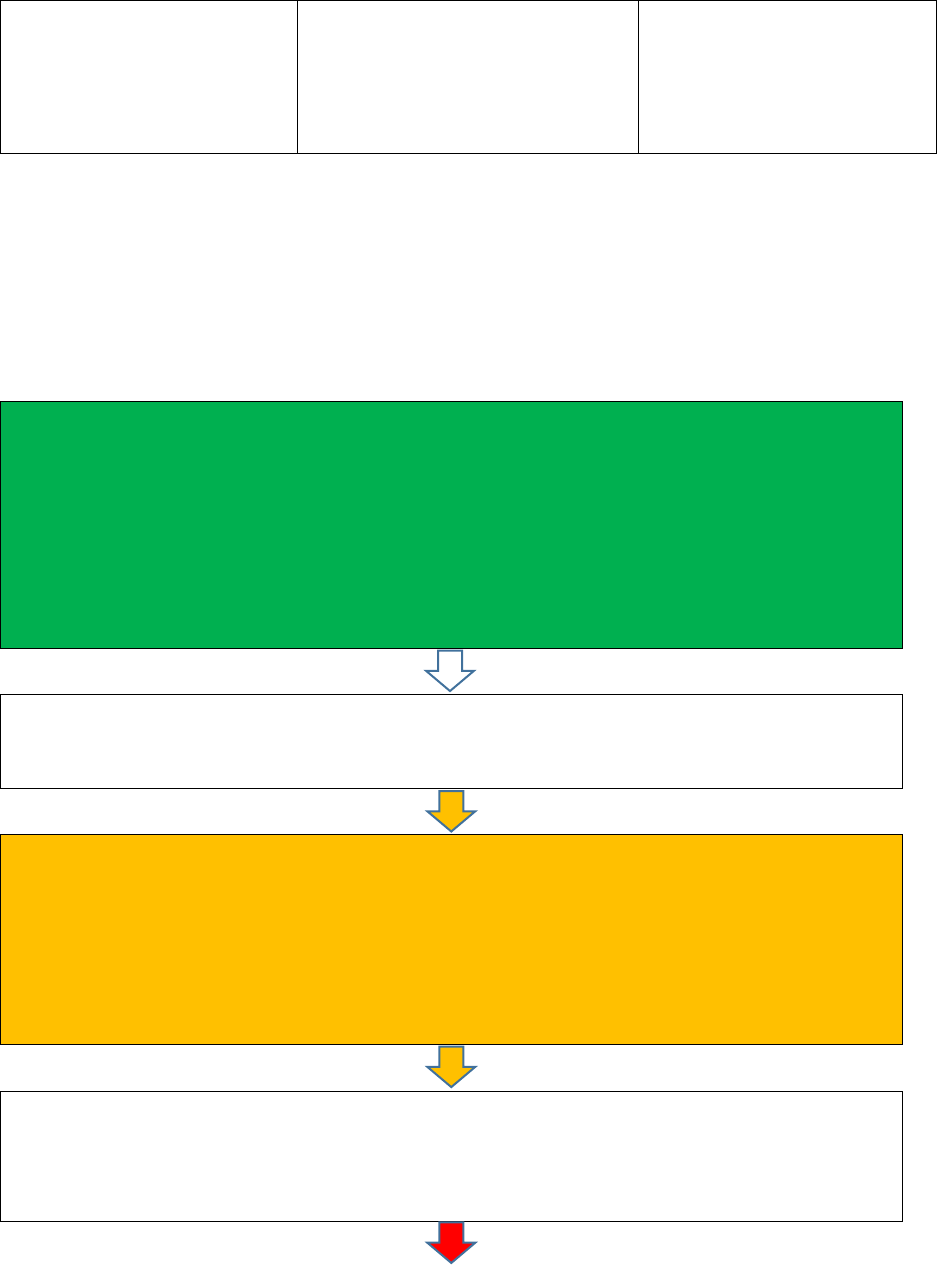
Hate-related incidents
Swearing
Our Behaviours Ladder
Green
I have had a great session, following the rules & the 9 habits
I am Ready, Respectful & Safe
Warning
I have needed a verbal reminder of the rules & 9 habits
Amber
I have needed a formal reminder of the rules & the 9 habits
Warning
I have needed a further verbal reminder of the rules & 9
habits

Red
I have not been Ready, Respectful or Safe and needed a
consequence
Using the Behaviour Ladder
Green
I have had a great session, following the rules & the 9 habits
I am Ready, Respectful & Safe
The behaviour ladder encourages children to stay on ‘Green’ throughout the day and earn a
Dojo point by doing so. The school day is broken down into three ‘Green Sessions’ in
recognition that we can all make mistakes but need the chance to reflect on our behaviour
and start the next session afresh. During the morning or afternoon sessions, a child can
move up and down the ladder accordingly and the ladder is reset at playtime, lunchtime and
at the end of the day. It should not be the only classroom management strategy used, and it
is assumed that a range of positive behaviour strategies should supplement and support it
such as giving Dojo points for displaying any of the 9 habits or going above and beyond
expectations.
Warning
I have needed a verbal reminder of the rules & 9 habits
If a child shows low level behaviour, they are issued a verbal warning. Warnings are given to
alert children to the impact that their behaviour has/is having on the ability of those around
them to learn effectively.
Warnings may be given for repeated incidents of low level, but disruptive, behaviour OR
one-off more serious incidents. For example:
• Talking at an inappropriate time
• Shouting out (unless during ‘Kind Calling-Out’ sessions)
• Causing a low-level distraction (e.g. deliberately making noises)

Amber
I have needed a formal reminder of the rules & the 9 habits
If, after a warning, this behaviour continues it will move to an ‘Amber’ card. An ‘Amber’ card
at the end of a session incurs – 1 Dojo point.
Children can also go straight to an Amber or Red card, these would be more serious one off
cases, such as rudeness or deliberately ignoring instructions given by the teacher.
Warning
I have needed a further verbal warning of the rules & 9 habits
One further verbal warning can be given for behaviour that continues to disrupt after an
Amber card has been issued.
Red
I have not been Ready, Respectful or Safe and needed a
consequence
Should this behaviour continue after a further verbal warning, they will move on to a ‘Red’
card for persistent poor behaviour or disruption. A ‘Red’ card at the end of a session
incurs a loss of 2 Dojo points.
An instant ‘Red’ card is given for:
• Physical violence or aggression against a child (that is not severe enough for
immediate suspension)
• Physical violence or aggression against an adult (that is not severe enough
for immediate suspension)
• Destruction of property
• Hate-related incidents (such as racist name-calling)
• Other Serious breaches of the Behaviour Policy.
All behaviour incidents culminating in Red cards are recorded on ‘CPOMS’ or Bromcom (as
appropriate) and parents/carers are informed using a standard message.
Consequences
Warnings are given to alert children to the impact that their behaviour has/is having on the
ability of those around them to learn effectively. They are not intended to single-out or
shame children and should be given following RIP and PIP good practice.
Where an Amber card has been given, a restorative conversation is needed with the
member of staff who issued the card. This needs to be done within the same session
wherever possible.
A red card leads to loss of privileges for the next play or lunchtime session and children
receiving a red card will need to spend 10 minutes of their time outside with the designated
adult on duty (or inside with a member of SLT if this is a possible alternative). No child
should lose an entire lunch time, nor should they lose multiple outdoor sessions. A
restorative conversation with the adult on duty should be had before the child returns to their
play or lunch session.
A red card issued for refusal to complete work will lead to the pupil completing the
assigned work in the next available play or lunch session.
Removal from the classroom
Removal from the classroom is a serious sanction and will only be used in response to
serious or persistent misbehaviour. This should not be confused with a period of ‘face swap’
where a child may spend time in an alternative classroom to give time to reflect and continue
to complete work which is a preferred de-escalation technique to prevent ‘red card’ incidents.
Staff will only remove students from the classroom once other behavioural strategies have
been attempted unless the behaviour is so extreme as to warrant immediate removal.
Removal can be used to:
• Restore order if the student is being disruptive.
• Maintain the safety of all students.
• Allow the disruptive student to continue their learning in a managed
environment.
• Allow the disruptive student to regain calm in a safe space.
Staff will record all incidents of removal from the classroom along with details of the incident
that led to the removal in the behaviour log. The Academy will decide whether it is necessary
to inform the student’s parents/carers. If a student is removed for a prolonged period (i.e.
More than one full session), the parent will always be informed.
Students will not be removed from classrooms for prolonged periods of time without the
explicit agreement of the Principal. Students should be reintegrated into the classroom as
soon as appropriate and safe to do so.
The Academy will consider what support is needed to help a student successfully reintegrate
into the classroom and meet the expected standards of behaviour.

Adaptations for SEND and SEMH needs
As an inclusive academy, we recognise that whilst the behaviour ladder is appropriate for the
vast majority of our pupils, it may not meet the needs of all. For this reason, we will
endeavour to adapt the ladder and/or consequences for children with identified SEND or
SEMH needs. These adaptations will be made on an individual basis, acknowledging that
not all children’s SEND or SEMH needs are the same. Individual behaviour plans will be
created for children requiring adaptations. These will be agreed with the Assistant Principals
for inclusion and wellbeing, class teachers, pupils and parents and will be reviewed regularly
as part of the assess-plan-do-review cycle.
Repeated poor behaviour
Should a child receive multiple red cards within a two-week period, the following
consequences will be applied:
Consequence
1
st
Red Card
Loss of privileges for the next play or lunchtime session and
children will need to spend 10 minutes of their time outside
with the designated adult on duty
2
nd
Red Card
Loss of privileges as above
Parents informed of a second red card incident
Pastoral support offered where appropriate
3
rd
Red Card
Loss of privileges as above
Parents informed of a third red card incident and invited to a
meeting with LS / class teacher
Report card issued by SLT which has to be completed each
session and signed every night by parents (to be monitored
each Friday by LS).
Rewards
All children will be given the opportunity to earn Dojo points. Each session where a child
remains on a ‘green card’ will earn 1 Dojo Point. Points will be awarded at the end of each
session (Playtime, lunchtime, home time). Additional points can be given for examples of
pupils going ‘Above and Beyond’, displaying the 9 habits, regular reading/homework or
displaying exemplary behaviour for learning.
Award certificates will be given out in Star of the Week assembly for reaching the following
milestones:
450 Dojos = Platinum Award
300 Dojos = Gold Award
200 Dojos = Silver Award
100 Dojos = Bronze Award
50 Dojos = Ticket for a Small Prize from SLT cupboard
The Academy recognises its legal duty under the Equality Act 2010 to prevent students with a
protected characteristic from being at a disadvantage. (See OCL Student Equality and Diversity
Policy) Consequently, our approach to challenging behaviour may be differentiated to cater to the
needs of the student. The school’s special educational needs co-ordinator and Senior Mental Health
Lead will evaluate a student who exhibits challenging behaviour to determine whether they have
any underlying needs that are not currently being met. Where necessary, support and advice will
also be sought from specialist teachers, an educational psychologist, medical practitioners and/or
others, to identify or support specific needs.
When acute needs are identified in a student, we will liaise with external agencies and plan support
programmes for that child. We will work with parents to create the plan and review it on a regular
basis.
We recognise that early referral to multi-agency support is vital in providing students with the
support that they need.
Systems, Structures Routines that ensure effective student transition
To ensure a smooth transition to the next year, students may have transition sessions with their new
teacher(s). In addition, staff members may hold transition meetings.
To ensure behaviour is continually monitored and the right support is in place, information related
to student behaviour issues may be transferred to relevant staff at the start of the term or year.
Information on behaviour issues may also be shared with new settings for those students
transferring to other schools.
Where students are transitioning to different Academies, for example from primary to secondary,
colleagues must take full account of information about students’ behaviour from feeder schools
including individual plans, where these are in place. (See OCL Admissions Policy for additional
support with transition.
Systems, Structures and Routines that reduce peer on peer abuse
Oasis adopts a zero tolerance approach to peer on peer abuse is most likely to include, but may not
be limited to:
• bullying (including cyberbullying, prejudice-based and discriminatory bullying);
• abuse in intimate personal relationships between peers;
• physical abuse such as hitting, kicking, shaking, biting, hair pulling, or otherwise
causing physical harm
• sexual violence
• causing someone to engage in sexual activity without consent,
• upskirting,
• initiation/hazing type violence and ritual
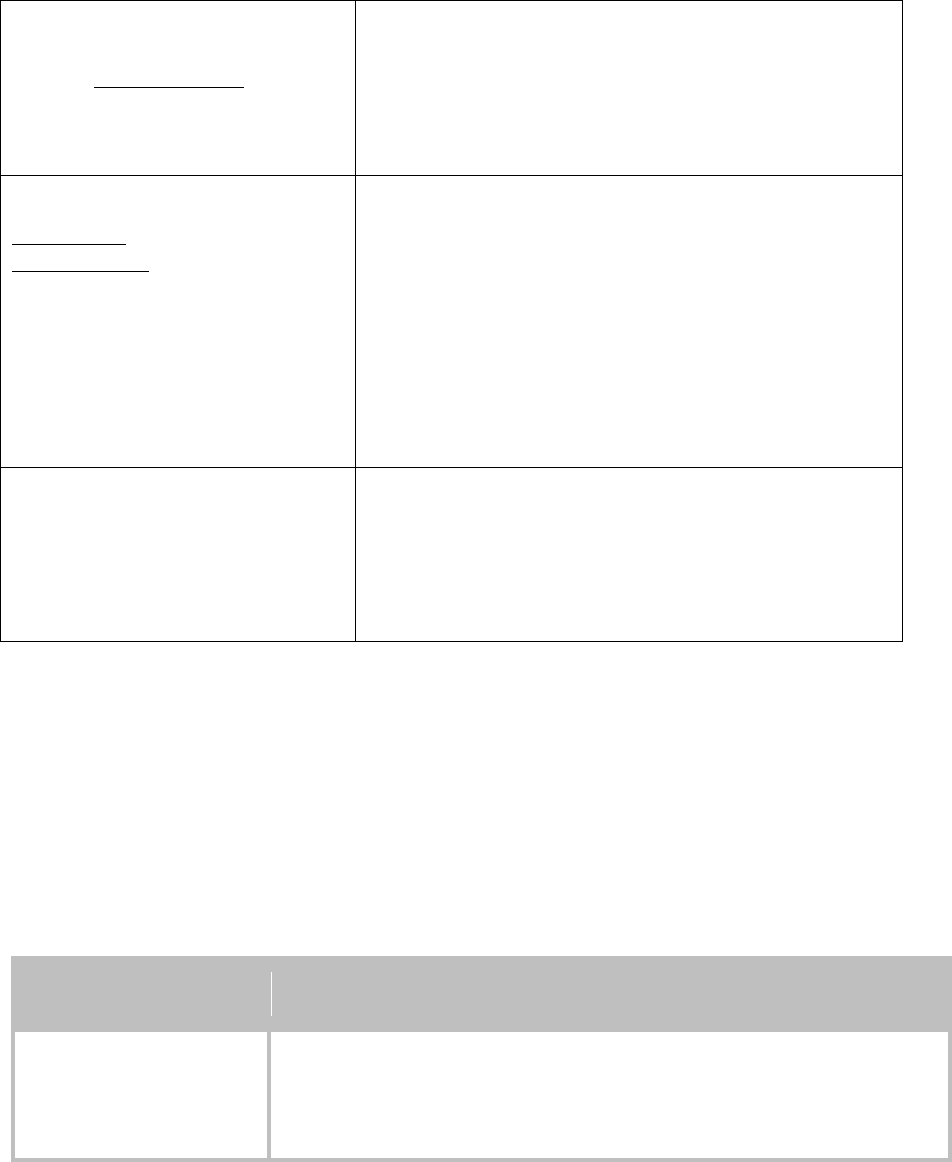
This is addressed within a 3-category approach
Category 1 – Harmful Sexual
Behaviour:
General single incidents of Cat 1
issues
Including but not limited to:
Developmentally inappropriate problematic (using the
Brook Traffic Light System as a benchmark),
Abusive sexualised behaviour on-line or off-line,
Lewd comments/jokes,
Creating a hostile, offensive or sexualised environment.
Category 2 – Sexual Harassment:
Two or more Cat 1 incidents, or
single incidents of Cat 2 issues and
recorded as a safeguarding incident
Including but not limited to:
Unwanted conduct of a sexual nature,
Up skirting
On-line or off-line sexualised comments, remarks or
observations,
Intentional touching of person or clothing,
Aggravated sexting,
Behaviours likely to violate dignity, feel intimidated,
degraded or humiliated
Creating a hostile, offensive or sexualised environment.
Category 3 - Sexual Violence:
Recorded on CPOMS as a child
protection incident
Including but not limited to:
Rape,
Assault by penetration,
Sexual Assault (touching in a sexual way without consent),
Grooming for sexual/criminal exploitation.
Bullying is defined as the repetitive, intentional harming of one person or group by another person
or group, where the relationship involves an imbalance of power. Bullying is, therefore:
• Deliberately hurtful
• Repeated, often over a period of time
• Difficult to defend against
Bullying can include: (including definitions from the NSPCC)
Type of bullying
Definition
Emotional
Being unfriendly, excluding (such as ignoring or isolating someone),
tormenting, humiliating, intimidating, threatening, controlling or
manipulating someone, silent, hoax or abusive calls

Physical
Hitting, kicking, pushing, taking another’s belongings, any use of violence
Racial
Racial taunts, graffiti, gestures
Sexual
Explicit sexual remarks, display of sexual material, sexual gestures,
unwanted physical attention, comments about sexual reputation or
performance, or inappropriate touching, homophobic, sexting with the
intention to harm, sharing of explicit images without consent
Direct or indirect verbal
Name-calling, sarcasm, gossiping, teasing, shouting, undermining by
constant criticism or spreading rumours
Cyber-bullying
Bullying that takes place online, such as through social networking sites,
messaging apps or gaming sites
Details of OCL’s approach to preventing and addressing bullying are set out in our Anti-Bullying
Policy available on the Oasis Zone through the Policy Portal.
All academies use Bromcom to record discriminatory events. This data is analysed at a national
and local level to ensure CPD focuses on need.
On-line Harm, Bullying or Slander
The online environment and social media afford our students an unlimited learning
opportunity and the right to access this environment is supported by Oasis. However with
rights come responsibilities and it is becoming increasingly common that fake social media
accounts are created and inappropriate content shared that seeks to harm others. This
online bullying and slander causes harm and distress to pupils, staff and the overall
reputation of the Academy and Oasis as a whole, and will not be tolerated. At no point
should any student create an account using the name of their academy or any identifying
features such as the academy logo.
As an organisation Oasis Community Learning wants to be crystal clear that hateful
behaviour, bullying and harassment is counter to the Ethos and Habits and has no place in
our schools. The distress these behaviours cause to our students and staff will not be
tolerated and we will address this both reactively when it is reported to us as well as
proactively.
Where abusive, slanderous or harmful content is reported the following actions will be taken:
• A report will be made to the social media site requesting that the item is removed.
• A report will be made to the Professional Online Safety Helpline (POSH, 0344 381
4772) for items relating to school staff
• A report will be made to the UK Safer Internet Centre (helpline@saferinternet.org.uk)

• Episodes that are deemed to be examples of Hate Crimes will be referred to the
police for full investigation
Where a student is identified as the author of this type of harmful material the appropriate
sanctions will be discussed with the parents/carer with the minimum expectation is that the
material will be removed immediately. If the career of a member of staff has been
compromised the potential for legal action exists.
In addition there is an expectation on the whole school community. As with episodes of
physical bullying where it is expected that bystanders do not encourage, endorse or
celebrate bullying – instead that it is reported. There is an expectation that our students will
not ‘like’ or ‘share’ episodes of online bullying of students or staff, and will report episodes to
staff as soon as possible. Students found to be acting by means of encouragement (liking or
endorsing) harmful posts are also subject to appropriate sanctions in line with anti-bullying
policies.
Oasis Academy Henderson Avenue principles: ‘Be Ready, Be Respectful and Be Safe’
We recognise that clear structure of predictable outcomes have the best impact on behaviour. Our
principle sets out the rules, relentless routines and visible consistencies that all children and staff
follow. Good behaviour is recognised sincerely rather than just rewarded. Children are praised in
public and reminded in private.
The academy has 3 simple rules ‘Be Ready, Be Respectful and Be Safe’ which can be applied
to a variety of situations and are taught and modelled explicitly.
We also understand that for some children, following our behaviour expectations is beyond their
developmental level. In this case, these children will have bespoke positive behaviour plans which
may include rewards to reinforce positive behaviour.
Our Rules
Visible Consistencies
1. Be Ready
2. Be Respectful
3. Be Safe
1. Daily meet and greet
2. Persistently catching children doing
the right thing
3. Picking up on children who are
failing to meet expectations
4. Accompanying children to the
playground at the end of every day
5. Praising in public (PIP), Reminding
in private (RIP)
6. Praise Boards
7. Consistent language

Consistent approach to discussing behaviours with children.
Stepped Boundaries - Gentle Approach, use child’s name, child level, eye contact, deliver message
1. REMINDER
I noticed you chose to …… (noticed behaviour)
This is a REMINDER that we need to be (Ready, Respectful, Safe)
You now have the chance to make a better choice
Thank you for listening
Example - ‘I notice that you’re running. You are breaking our school rule of being
safe. Please walk. Thank you for listening.’
2. WARNING
I noticed you chose to …… (noticed behaviour)
This is the second time I have spoken to you.
You need to speak to me for two minutes after the lesson.
If you choose to break the rules again you will leave me no choice but to ask you
to, (work at another table/work in another classroom / go to the quiet area etc
………….) (learner's name),
Do you remember when ………………………………………. (model of previous good
behaviour)? That is the behaviour
I expect from you. Think carefully. I know that you can make good choices Thank you
for listening / I’m glad we had this conversation
Example - ‘I have noticed you are not ready to do your work. You are breaking the
school rule of being ready. You have now chosen to catch up with your work at
playtime. Do you remember that yesterday you started your work straight away and
got it finished? That is what I need to see today. Thank you for listening.’
3. TIME OUT
I noticed you chose to …… (noticed behaviour)
You need to………….(Go to quiet area / Go to sit with other class / Go to another
table etc)
Playground: You need to ………….(Stand by other staff member/ me / Sit on the picnic
bench/ stand by the wall etc)
I will speak to you in two minutes
Example - ‘I have noticed you chose to use rude words. You are breaking the school
rule of being respectful. You have now chosen to go and sit in the quiet area. I will
come and speak to you in two minutes. Thank you for listening.’
*DO NOT describe child’s behaviour to other adult in front of
the child*
4. FOLLOW UP
– REPAIR &
RESTORE
5. What happened? (Neutral, dispassionate language.)
6. What were you feeling at the time?
7. What have you felt since?
8. How did this make people feel?
9. Who has been affected? What should we do to put things right? How can we
do things differently?
*Remember it’s not the severity of the sanction, it’s the certainty that this follow up will
take place that is important.

Physical Intervention
This policy is based upon protocols and advice from the Department for Education
(DfE) on:
• Behaviour and discipline in schools
• Searching, screening and confiscation at school
• The Equality Act 2010
• Use of reasonable force in schools
• Supporting students with medical conditions at school
Localised Behaviour protocols must also be based on the special educational needs
and disability (SEND) code of practice.
In addition, this policy and localised protocols are based on:
• Schedule 1 of the Education (Independent School Standards)
Regulations 2014; paragraph 7 outlines a school’s duty to safeguard and
promote the welfare of children, paragraph 9 requires the school to have a
written behaviour policy and paragraph 10 requires the school to have an
antibullying strategy
• DfE guidance explaining that Academies should publish their
behaviour policy and anti-bullying strategy online – to ensure that staff,
students and parents are informed
Physical intervention
See DfE guidance: Use of reasonable force in schools
In some circumstances, staff may use reasonable force to intervene with a student to
prevent them:
• Causing disorder that disrupts learning
• Hurting themselves or others
• Damaging property that leads to the injury of others Incidents of physical
intervention must:
• Always be used as a last resort
• Be applied using the minimum amount of force and for the minimum
amount of time possible
• Be used in a way that maintains the safety and dignity of all concerned
• Never be used as a form of punishment
• Be recorded and reported to parents
A whole school training package (Dynamis) is used for everyone who encounters
children in the academy to help stop behaviours escalating and assist with whole
positive behaviour management culture and ethos.

A smaller group of senior staff have received practical face to face training and
additional resources. This group will be ‘Positive Behaviour Management – conflict
management- trained with positive handling elements.
Recording of physical intervention
The following should be included in a record of intervention. This can be completed
using CPOMS:
• The date, time and place of the incident
• The name of the student involved, date of birth and their year group
• What triggered the behaviour
• What diffusing techniques were used prior to physical intervention
• Why the physical intervention was deemed necessary
• Place where the incident happened
• Time and date parents were informed
• Injuries sustained – if any
Class Logs: Classroom teachers will record minor behavior incidents/parental contact within their
class logs. These need to be updated regularly and will be used by the SLT/SEMH team for gathering
evidence to inform future actions including the escalation of additional support and referral to
external agencies.
CPOMs: Serious behaviour incidents must be recorded using the CPOMs system as soon as
possible after the incident has occurred. For protocols and procedures please refer to the CPOM
policy.
Fixed Term Exclusions will occur following extreme incidents at the discretion of the Principal. A
fixed-term exclusion will be enforced under these conditions:
• The child needs time to reflect on their behaviour
• To give the school time to create a plan which will support the child better
• The child being at home will have a positive impact on future behaviour
If these conditions are not met, other options may include a day of Internal Isolation which will
be supervised and managed by members of the SEMH team. This decision will be made by
either the Principal or in her absence by the Deputy Principal.
We understand that throughout this process, it is imperative that we explain what is happening and
why it is happening to parents and arrange meetings to discuss.
Physical Attacks on Adults
At Oasis Academy Henderson Avenue, we take incidents of violence toward staff very seriously. We
also understand that staff are the adults in the situation and can use a ‘common sense’ approach to
keep themselves and the child safe to manage the situation effectively. Staff can use ‘reasonable
measures’ to protect themselves in accordance with our Physical Intervention and Use of

Reasonable Force Policy and should call for support if needed. Only staff who have been trained in
physical restraint should restrain a child.
All staff should report incidents directly to the Principal or Deputy Principal and they should be
recorded on CPOMs. We appreciate these incidents can cause distress for the adults involved,
therefore all staff are entitled to take some time away from the classroom to recover their
composure. In extreme cases, the member of staff may be allowed to go home with the permission
of either the Principal or Deputy Principal.
Whilst incidences of violence towards staff are wholly unacceptable, we must remember that we
are a nurturing school that values each child under our care. It is important for us as adults to
reflect on the situation and learn from our actions. Children who attack adults may do this for
several reasons but as adults we need to still show compassion and care for the child. Exclusion
will only happen once we have explored several options and have created a plan around a child.
Permanent Exclusion or Out Of School Transfer
Exclusion is an extreme step and will only be taken in cases where:
• Long term misbehaviour is not responding to the strategies and the safety and learning of
others is being seriously hindered.
• The risk to staff and other children is too high
• The impact on staff, children and learning is too high
Permanent exclusion will be a last resort and the academy will endeavour to work with the family to
complete a managed transfer to a more suitable setting. In all instances, what is best for the child will
be at the heart of all our decisions.
Beyond the Academy Gate
Whilst this behaviour policy refers mainly to the behaviours of pupils within academy premises,
the academy reserve the right to discipline beyond the school gate.
Our policy covers any inappropriate behaviour when children are:
• taking part in any school organised or school related activity
• travelling to or from school
• wearing school uniform
• in some way identifiable as a pupil from our school
• poses a threat to another pupil or member of the public
• could adversely affect the reputation of the school
•
In the incidences above, the Police/PCSOs may be notified and appropriate action taken against a
pupil. If the behaviour is criminal or causes threat to a member of the public, the police will always
be informed.
Out of Academy Behaviour
The academyl is committed to ensuring our pupils act as positive ambassadors for us. Taking
the above into account, we expect the following:
• Good behaviour to and from the academy, on educational visits or during learning
opportunities in other schools

• Positive behaviour which does not threaten the health, safety or welfare of our pupils, staff,
volunteers or members of the public.
• Reassurance to members of the public about academy care and control over pupils in order to
protect the reputation of the academy.
• Protection for individual staff and pupils from harmful conduct by pupils of the academy when
not on the academy site.
• The same behaviour expectations for pupils on the academy premises apply to off-site
behaviour.
Sanctions and Disciplinary Action – Off-Site Behaviour
Sanctions may be given for poor behaviour off the academy premises which undermines any of
the above expectations and regardless of whether or not it is an activity supervised directly by
academy staff. Sanctions may be in the form of withdrawal of privileges, fixed term exclusion or in
very serious cases, permanent exclusion. In issuing sanctions, the following will be taken into
account:
• The severity of the misbehaviour
• The extent to which the reputation of the academy has been affected.
• Whether pupils were directly identifiable as being a member of our academy.
• The extent to which the behaviour in question could have repercussions for the orderly running
of the academy and/or might pose a threat to another pupil or member of staff (e.g. bullying
another pupil or insulting a member of staff).
• Whether the misbehaviour was whilst the pupil was taking part in learning opportunities
in another school, participating in a sports event (and in any situation where the pupil is acting
as an ambassador for the academy) which might affect the chances or opportunities being
offered to other pupils in the future
LEVER 4: BEHAVIOUR TRAINING AND PROFESSIONAL DEVELOPMENT
Training and Professional Development: Academy Leaders
The research and evidence-based approach to CPD that the Trust takes to ensure maximum
efficiency and impact in Pedagogy Professional Development is replicated for Behaviour
Management in Oasis Schools. All staff are equipped, prepared for and effective in ensuring this
pastoral care is exemplary. All staff are supported to develop increasingly powerful insights into
what works in developing character and preparedness for adult life.
• Leaders will ensure that through CPD staff understand and embody the Oasis ethos and values
• Leaders use a range of evidence (for example, attendance and behaviour data, students’ work,
student voice, the observation of pastoral staff) to assess the effectiveness of pastoral learning
• Leaders ensure that all pastoral staff know exactly what they need to work on in order to
improve the climate for learning and pastoral outcomes in groups for which they are
responsible. Staff have clear, precise developmental targets and review conversations are
focused, practical, and enabling. Leaders will regularly follow up agreed targets to assess their
impact.
• Leaders act swiftly whenever and wherever less-effective practice is identified. They provide
robust support and challenge, which may include intensive and regular observation, coaching
and training.
• Leaders are committed to on-going pastoral professional learning for all and are relentless in
providing opportunities for all staff in pursuit of this goal.
• Leaders utilise the power of deliberate practice to improve pastoral quality. They build
opportunities for staff to practise core skills on a regular basis.
• Leaders role-model engagement in research around pastoral learning and work to
disseminate best practice and key knowledge to all staff.
• Leaders create an environment where great pastoral practice is used to improve pastoral
quality within and beyond their own schools.
• Leaders make effective use of a range of Trust expertise – for example, the Monitoring
Standards Team, the Directory of Best Practice, Regional Improvement Networks and our
National Lead for Pastoral Innovation – to help us secure more rapid improvements in the
quality of students’ pastoral learning.
• Leaders actively seek to ensure staff know how to remove barriers to learning including social
disadvantage and special educational needs and disability. This includes resourcing strategies
that close the gap between the most and least advantaged [including LAC] in terms of
attendance, exclusion, and destinations. For SEND, the focus is on inclusion, integration, high
quality learning and preparation for the next phase of education, employment, or training.
CPD
To ensure that we are 'deliberate' and 'purposeful' with our behaviour professional development as
we are with our pedagogical professional development.
Engage with expert/specialist training where necessary on the following areas:
• Senior Mental Health Lead training
• Mental Health First Aid for pastoral leaders
• ACES and Trauma Informed Practice
• Managing an investigation of an incident
• Restorative justice/mediation
• Physical restraint training
• Attendance systems/structures
• Reintegration following fixed term exclusions
• Effectively issuing a report/tracker
• Impactful parent meetings
• Multi-agency meetings
• Managing grief
• Managing self-harm
• Preventing and dealing with bullying
• Parental classes
• Sexual orientation, gender identity and LGBTQ+ empowerment
Pastoral Professional Development for teaching staff could focus on the following areas:
• Differentiation
• How we plan lessons to maximise engagement and minimise low level disruption
• Expectations and role modelling
• De-escalation and Diffusion
• Restorative approaches
• How to be effective on break, lunch, after/before school duty
Differentiation
• A clear understanding that all children and young people have different starting points and
that there is a difference between uniformity and consistency, so children and young people
will need different strategies on their journey of improvement.
• Clear expectations explained for all students taking account of students’ age, developmental
stage, their SEND and/or EAL
• Adults work with each student as an individual; knowing their interests, aspirations,
developmental and/or special need or disability
How we plan our lessons
• Ensuring that the work set for students matches their stage of development, learning need/s
and interests
• Adjusting the pace of learning during lessons, based on student’s ability and progress
• Providing a challenging, stimulating, and relevant curriculum
• Providing safe, supportive learning environments, physically and emotionally – this may
include flexible layout of space and furnishings, grouping of students, seating plans, use of
visual organisers, specific resources to support knowledge, understanding and skills
development, personalised workstations, etc.
Expectations and role modelling
• Good behaviour needs to be explicitly taught and well modelled by staff (see Trust Learning
Policy)
• Consistent, calm, and fair application of approach or strategy by all adults
• Being enthusiastic, clear, and consistent about expectations to create a positive classroom
atmosphere
• Adults provide consistent and effective role models underpinned by high quality interactions
with students during lessons and at other times of the day
De-escalation & Diffusion (CPD at Academy level will be required to implement this)
De-escalation techniques should be employed to reduce the impact of poor behaviour. More
specifically:
• using non-verbal cues
• allowing adequate personal space
• using active listening techniques (e.g., LEAPS - listen, empathise, ask questions, paraphrase,
and summarise actions for moving forward)
• adopting a non-threatening body stance and body language (open, relaxed with hands down)
• acknowledging the student's underlying or expressed emotion (e.g., anger/distress)
• problem solving with the student to address the cause of escalation if safe to do so
• keeping verbal instructions simple and minimal, using a calm tone of voice and clear, direct
language or student's preferred method of communication (focusing on the behaviours you
want them to display rather than the ones you don't)
• distracting the student from the source of any anger or distress by discussing another topic
they are interested in
• providing options (within limits) to help the student feel they are still in control of their
decisions
• going to an alternative space with the student that is less stimulating or removes access to the
triggers
• appropriate filtering and monitoring on IT devices
• the use of any individual techniques on a child’s individual behaviour plan or SEND plan
• using reflection tools to enable students to self-identify their own behaviour and to support
them in the process of discovering ways of self-regulating that behaviour
Restorative practice
Leaders may want to implement a restorative justice approach in their Academy. Restorative
practices are solution focused. Restorative justice brings together the victims with those responsible
for the harm, to find a positive way forward.
Restorative justice gives victims the chance to tell offenders the real impact of their crime, get
answers to their questions and get an apology. Restorative justice holds offenders to account for
what they have done. It helps them understand the real impact, take responsibility, and make
amends. Using these opportunities for personal development can be one of the most powerful
means of self-improvement. Restorative Practice is not an easy solution, as it should be used

alongside the Academy’s behaviour guidance and consequences. In incidents of peer on peer abuse,
particularly at the level of category 2 and category 3 incidents the use of restorative practice should
be very carefully considered as confronting the abuser may cause the victim to re-live the
experiences. https://restorativejustice.org.uk/restorative-practice-schools OCL Academies currently
using restorative practice include: OA Lister Park, OA Mayfield and OA Ryelands.
Discipline in our academies – teacher’s powers
Key Points
• Teachers have statutory authority to discipline students whose behaviour is unacceptable,
who break the Academy rules or who fail to follow a reasonable instruction (Section 90 and
91 of the Education and Inspections Act 2006).
• The power also applies to all paid staff (unless the head teacher says otherwise) with
responsibility for students, such as teaching assistants
• Teachers can discipline students at any time the student is in the Academy or elsewhere under
the charge of a teacher, including on Academy visits
• Teachers can also discipline students in certain circumstances when a student’s misbehaviour
occurs outside of the Academy
• Teachers have a power to impose detention outside Academy hours. It is good practice to take
all practicable steps to inform parents that this is taking place
• Teachers can search and confiscate students’ property (More detail later in the policy)
Consequences for poor behaviour
What the law allows:
• Teachers can discipline students whose conduct falls below the standard which could
reasonably be expected of them. This means that if a student misbehaves, breaks an Academy
rule or fails to follow a reasonable instruction the teacher can impose a consequence on that
student
• To be lawful, the consequence (including detentions) must satisfy the following three
conditions:
1. The decision to give a student a consequence must be made by a paid member of
Academy staff or a member of staff authorised by the Principal;
2. The decision to reprimand the student and the consequence itself must be made on
the Academy premises or while the student is under the charge of the member of
staff; or is a breach of the Academy Behaviour Policy;

3. It must not breach any other legislation (for example in respect of disability, special
educational needs, race and other equalities and human rights) and it must be
reasonable in all the circumstances.
• A consequence must be proportionate. In determining whether a consequence is
reasonable, Section 1 of the Education and Inspections Act 2006 says the penalty must be
reasonable in all the circumstances and that account must be taken of the student’s age, any
special educational needs or disability they may have, and any religious requirements
affecting them
• The Principal may limit the power to apply particular consequences to certain staff and/or
extend the power to discipline to adult volunteers, for example to parents who have
volunteered to help on an Academy trip
• Corporal punishment is illegal in all circumstances
• Academies should consider whether the behaviour under review gives cause to suspect that
a child is suffering, or is likely to suffer, significant harm. Where this may be the case,
Academy staff should follow the OCL Safeguarding Policy. They should also consider whether
continuing disruptive behaviour might be the result of unmet educational or other needs. At
this point, the Academy should consider whether a multi-agency assessment or care plan is
necessary.
Physical intervention
See DfE guidance: Use of reasonable force in schools
All Oasis settings will use the Team Teach methodology when considering reasonable force and
physical intervention
In some circumstances, staff may use reasonable force to intervene with a student to prevent them:
• Causing disorder that disrupts learning
• Hurting themselves or others
• Damaging property that leads to the injury of others
Incidents of physical intervention must:
• Always be used as a last resort
• Unless in an emergency situation, physical intervention techniques should only be applied by
those trained to use them
• Be applied using the minimum amount of force and for the minimum amount of time possible
• Be used in a way that maintains the safety and dignity of all concerned
• Never be used as a form of punishment
• Be recorded and reported to parents

Recording of physical intervention
The following should be included in a record of intervention. This can be completed using BromCom:
• The date, time and place of the incident
• The name of the student involved including their date of birth and their year group
• What triggered the behaviour
• What diffusing techniques were used prior to physical intervention
• Why the physical intervention was deemed necessary
• Place where the incident happened
• Time and date parents were informed
• Injuries sustained – if any
• The use of the OCL pupil statement form to collect witness statements
The RD should undertake a check on Academy physical restraint records regularly. These should be
available on CPOMs.
Individual plans: The complexity and range of need and consequent support for some children and
young people with specific needs may be such that physical intervention is the norm and not the
exception. Such planned physical intervention should be recorded and monitored through the young
person’s individual plan. In order to link to the Oasis Ethos and 9 habits each plan should link to the
habits and involve the student identifying at least one or more of the habits they need to embed as
part of their character.
Training: If there is a need in the Academy for physical intervention staff should have regularly
updated training in physical restraint. Principals should consider whether members of staff require
any additional training to enable them to carry out their responsibilities and should consider the
needs of the students when doing so. Team Teach Training should be undertaken by a recognised
provider. The MAT Leadership will provide advice and guidance to help schools to develop an
appropriate training program. All training should be accredited by BILD
http://www.bild.org.uk/our-services/workplace-training/
Absconding – leaving without permission
OCL Academies have a duty of care to take all reasonable steps to ensure that children and students
are kept safe whilst in the Academy’s care. Academies should ensure that to reduce the potential for
absconding the following is in place:
• The site is secure
• Supervision levels are appropriate
• Academy rules are clear to students and children
• Individual risk assessments in place where absconding is a possibility for a student
• Visits to venues for Academy trips in advance of an educational visit to undertake a risk
assessment
Academies will have their own localised procedures in the event of a student absconding and these
will include:
• Informing the Leadership Team immediately
• Not putting other students at risk
• Locating the student
• Potentially following the student at a safe distance once the student leaves the Academy
grounds – a decision made for each individual student by academy leaders (mobile phones
must be carried to keep the staff member safe and enable communication) - professional
judgement and local “on the spot” risk assessments should be made to keep all parties safe
• Strategies for diffusing and de-escalation and returning the student to the Academy (This may
involve staff training)
• Informing the parents or guardians
• Informing the police – if the student cannot be found
• Follow up meeting with the student and their parents
• A risk assessment developed for the student
Malicious allegations
The needs of pupils falsely or maliciously accused of peer-on-peer incidents should be considered in
each academy and support mechanisms put in place to ensure that they are able to settle back into
school without any residual impact.
Where a student makes an accusation against a member of staff and that accusation is shown to
have been malicious, the Principal will discipline the student in accordance with this policy. Please
refer to the OCL Safeguarding Policy and OCL Whistleblowing Policy for more information on
responding to allegations of abuse. The pastoral needs of staff accused of misconduct must always
be considered by leaders.
Confiscation
Any prohibited items (which should be listed in the Academy’s behaviour protocol) found in
students’ possession will be confiscated. These items will not be returned to students.
We will also confiscate any item which is harmful or detrimental to Academy discipline. These items
will be returned to students after discussion with senior leaders and parents, if appropriate.

Searching and screening students is conducted in line with the DfE’s latest guidance on searching,
screening and confiscation but should only be undertaken a member of the senior leadership, of the
same gender as the pupil being searched and witnessed by another staff member.
Exclusions/Suspensions
The removal of a student from the Academy should be used only as a last resort in response to
'serious breaches' or repeated breaches of a school's behaviour policy or to safeguard the welfare
and education of other students. We use a range of strategies to reduce exclusions including Trauma
Informed Practice, support for mental health and inclusion rooms in our academies.
As such, permanent exclusion is normally the final and most serious step taken in an Academy’s own
disciplinary process. It may follow several fixed period exclusions (these cannot total more than 45
days in a school year) and other in-school measures, including regular consultation with parents,
behaviour contracts or a "managed move" to another school.
Following an exclusion an Academy should reflect on its level of inclusivity – “Can we do anything
differently to avoid permanent exclusions?” See: OCL Exclusions policy
Horizons
The Horizons project has provided every student with an iPad. The project supports the vision of
equal opportunities for all by ensuring equality of access to technology and the resources and
knowledge that it facilitates. The device remains the property of Oasis Community Learning at all
times. All users must adhere to the rules around appropriate usage outlined in the individual
academies localised Behaviour Policy. Failure to do so may result in the device being confiscated or,
in some cases, further consequences being imposed.
Monitoring
This behaviour policy will be reviewed regularly by the National Education Team. At each review, the
policy will be approved by the CEO and Director’s group.
Links to other policies
This behaviour policy is linked to the following policies:
• OCL Exclusions policy
• OCL Safeguarding policy

• OCL Anti-bullying policy
• OCL SEND policy
• OCL Learning Policy
• OCL Physical Intervention Policy
• OCL Staff Code of Conduct Policy
Responsibilities
The Regional Director
The Regional Director is responsible for monitoring the effectiveness of each Academy’s localised
behaviour protocol and holding the principal to account for its implementation.
The MET
The Monitoring and Evaluation Team evaluate the impact of the Academy localised behaviour policy
on learning. The MET give feedback and identify next steps for the Principal and Regional Director.
The Safeguarding Team
The Safeguarding Team will look at the application of the behaviour policy through the lens of
safeguarding and will advise and support the Principal and DSL on steps to further protect their
pupils.
The Principal
The principal is responsible for reviewing and approving this localised behaviour policy. The principal
will ensure that the Academy environment encourages positive behaviour and that staff deal
effectively with poor behaviour, and will monitor how staff implement this policy to ensure rewards
and consequences are applied consistently.
Staff
Managing student behaviour is everyone’s responsibility. Staff are responsible for:
• Being role models of positive behaviour
• Reminding students of non-negotiables or ground rules regularly
• Implementing the behaviour policy consistently including challenging behaviours when seen
• Providing a personalised approach to the specific behavioural needs of particular students
• Recording behaviour incidents

• The senior leadership team will support staff in ensuring that they take ownership in
responding to behaviour incidents.
Parents
Parents should be informed about examples of good student behaviour and/or a positive or negative
change in behaviour. Partnership between family and academy is vital for the promotion of an
effective behaviour protocol.
Parents should be consulted when an aspect of the Academy’s behaviour protocol is likely to change
through a regular parent forum (both formal and informal opportunities as needed).
Parents are expected to:
• Support their child in adhering to the student code of conduct
• Inform the Academy of any changes in circumstances that may affect their child’s behaviour
• Discuss any behavioural concerns with the class teacher promptly
Students
Students, including those with additional needs, should be fully aware of rewards and consequences
for behaviour. They should be encouraged to take ownership of their own behaviour to enable them
to become effective members of their community.
Students are expected to:
• Understand and keep to the student code of conduct
• Discuss any concerns with the class teacher or DSL promptly
Training requirements
See Lever 4 for detail on staff training.
Statutory requirements
This policy and localised protocols developed in OCL Academies must follow advice from the
Department for Education (DfE) on:
• Behaviour and discipline in schools
• Searching, screening and confiscation at school
• The Equality Act 2010
• Use of reasonable force in schools
• Supporting students with medical conditions at school

Localised Behaviour protocols must also be based on the special educational needs and disability
(SEND) code of practice.
In addition, this policy and localised protocols must be based on:
• Schedule 1 of the Education (Independent School Standards) Regulations 2014; paragraph 7
outlines a school’s duty to safeguard and promote the welfare of children, paragraph 9
requires the school to have a written behaviour policy and paragraph 10 requires the school
to have an anti-bullying strategy
• DfE guidance explaining that Academies should publish their behaviour policy and anti-
bullying strategy online – to ensure that staff, students, and parents are informed

Application
This Behaviour Policy is for all of our academy community. If it is to be effective, everyone must
use it with confidence and consistency.
There may be occasions when adaptations may need to be applied e.g. swimming pool, science or
technology lessons, but the same principles of promoting good behaviour through the policy will
always apply.
Academy
Leaders
• Leaders are trained on using Academy data systems to ensure behaviour
monitoring is robust and effective.
• Pastoral staff have clear targets and accountability to ensure the vision of
behaviour for learning is achieved. Less than effective practice is challenged quickly
and improved.
• Leaders are committed to on-going pastoral professional learning for all and are
relentless in providing opportunities for all staff in pursuit of this goal.
• Leaders utilise the power of deliberate practice to improve pastoral quality. They
build opportunities for staff to practise core skills on a regular basis.
• Leaders role-model engagement in research around pastoral learning and work
to disseminate best practice and key knowledge to all staff.
• Leaders create an environment where great pastoral practice is used to improve
pastoral quality within and beyond their own schools.
• Leaders actively seek to ensure staff know how to remove barriers to learning
including social disadvantage and special educational needs and disability.
Academy
Staff
To ensure that we are 'deliberate' and 'purposeful' with our behaviour professional
development as we are with our pedagogical professional development. Engage
with expert/specialist training where necessary on the following areas:
• Mental Health First Aid for pastoral leaders
• Team Teach training for SEMH team.
• Managing an investigation of an incident
• De-escalation & diffusion.
• Attendance systems/structures
• Reintegration following fixed term exclusions
• Effectively issuing CPOMs and classroom behaviour logs
• Impactful parent meetings
• Multi-agency meetings
• Managing grief
• Managing self-harm
• Preventing and dealing with bullying
• Parental classes
• Sexual orientation, gender identity LGBTQ empowerment
Restorative
practice
Staff and children involved are trained by the behaviour lead on supervising, structuring
and recording a restorative practice session using the materials outlined in this policy in
Lever 3 section above.
